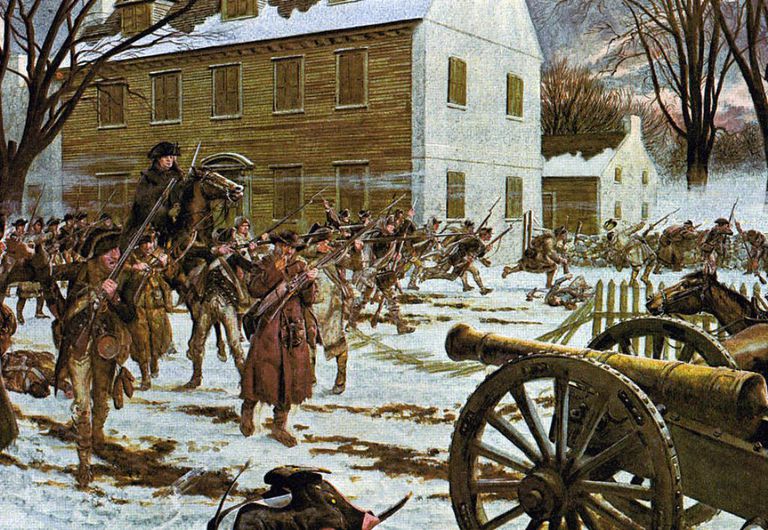The Battle of Trenton was a small but crucial battle during the American Revolutionary War. It happened on the morning of December 26, 1776, in Trenton, New Jersey.
The Battle of Trenton
- The Americans’ (with 2400 soldiers) march toward Trenton began at 4 AM. As the soldiers marched, many left trails of blood from their bleeding feet.
- About 2 miles (3 km) outside the town, the soldiers were startled by the sudden appearance of 50 armed men, but they were American. This small group had attacked a Hessian outpost earlier. Washington feared the Hessians would have been put on guard, and shouted at their leader, “You sir! You sir, may have ruined all my plans by having them put on their guard.”
- In fact, the 50 men actually helped Washington. The Hessian commander Rall had been warned about a possible American attack, but he thought the first raid was the attack and that there would be no further action that day.
- Washington’s army reached Trenton around 8 AM.
- The Hessians were completely surprised. Most were asleep when the Americans arrived.
- They tried to form lines, but the American cannons were already pouring devastating fire into the Hessians. (Part of the American artillery was commanded by a young captain named Alexander Hamilton). American musket fire also decimated the Hessians. Much hand-to-hand fighting occurred.
- Within an hour, the Hessians surrendered. The Americans had suffered only two deaths (due to exposure, not gunfire) and five wounded. One of the wounded was a young lieutenant named James Monroe.
- 22 Hessians were killed (including Col. Rall), 83 were wounded, and 800-900 surrendered and became prisoners. At least 500 Hessians escaped.
Second Trenton (Assunpink Creek)
- After his victory at the Battle of Trenton, Washington crossed the Delaware back into Pennsylvania, taking their prisoners and captured supplies with them. They were back by noon.
- Washington was expecting a British counterattack. He decided to re-cross the river on December 30 and deploy the army, on the south side of the Assunpink Creek. There the soldiers built fortifications.
- Washington, knowing that many of his men’s enlistments were due to expire the next day, made an appeal to them to reenlist. He said “If you will stay one month longer, you will render that service to your country that might not be possible under any circumstance.”
- Soon after this, one man stepped forward, then another, then another. Eventually, nearly all of Washington’s men agreed to stay. One of Washington’s officers asked him, “Should we get them to sign something?” “No,” Washington replied, “Men who will volunteer in such a case as this need no enrollment to keep them to their duty.”
- Cornwallis, who had 8,000 troops in Princeton, sent 5,500 of them to attack Washington on January 2.
- Washington sent a force under the command of Colonel Edward Hand to stop them. Hand’s men deployed at Five Mile Creek.
- As the British approached, Hand’s force fell back. American sharpshooters harassed the British, delaying their approach by hours.
- Washington sent more soldiers forward, delaying the British even more. It was almost dark before the British reached the main American position behind the creek.
- Three Virginia regiments protected a bridge across the creek that the British would have to cross to get to the main American force. One American officer shouted “Well, boys, you know the old boss has put us here to defend the bridge, and by God, it must be done. Bring down your pieces, fire at their legs…one man wounded in the leg is better than a dead one, for it takes two more to carry him off, and there is three gone. Leg ‘em, damn ‘em, I say leg ‘em!”
- The British attacked the Americans and were driven back twice. Washington sent in his reserves under the command of John Cadwalader. The British and Germans lost about 500.
- The British make a third attack and are again driven back. They stopped for the day. Cornwallis plans to finish off the Americans in the morning. He said “We’ve got the old fox now. We’ll go over and bag him in the morning.”
- One American soldier wrote “There dead bodies lay thicker and closer together for a space than ever I beheld sheaves of wheat lying in a field over which the reapers had just passed.”
- When the British advanced the next day, the Americans were gone. Washington and his army had slipped around them during the night and marched toward the remainder of the British army in Princeton.
This article is part of our larger selection of posts about the Revolutionary War. To learn more, click here for our comprehensive guide to Revolutionary War.
This article is also part of our larger selection of posts about Colonial America. To learn more, click here for our comprehensive guide to Colonial America.
This article is also part of our larger selection of posts about American History. To learn more, click here for our comprehensive guide to American History.
Cite This Article
"Battle of Trenton: Location, Facts and Summary" History on the Net© 2000-2024, Salem Media.
April 26, 2024 <https://www.historyonthenet.com/battle-of-trenton-location-facts-summary>
More Citation Information.






